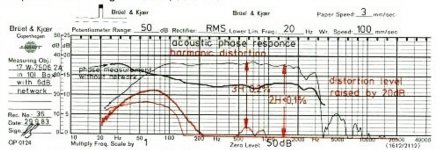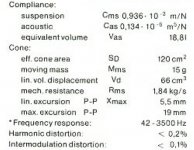Hello
I know that under 80 hz it should become very difficult to localize a sound.
I did want to test my low frequencies earing and sound localisation. So I use my sinewave generator and for a first test I did a 500 hz to 25 hz sweep tone test on the right channel speaker only, and after I did the same sweep tone test on the left channel speaker only.
I both tests I could easily localize the sound, even down to 35 hz.
Under 80 hz it should become very difficult to localize the sound, but I could easily localize the very low frequencies sounds. Did I done an error in my test, or some peoples can more easily localize very low frequencies sounds ?
Thank
Bye
Gaetan
I know that under 80 hz it should become very difficult to localize a sound.
I did want to test my low frequencies earing and sound localisation. So I use my sinewave generator and for a first test I did a 500 hz to 25 hz sweep tone test on the right channel speaker only, and after I did the same sweep tone test on the left channel speaker only.
I both tests I could easily localize the sound, even down to 35 hz.
Under 80 hz it should become very difficult to localize the sound, but I could easily localize the very low frequencies sounds. Did I done an error in my test, or some peoples can more easily localize very low frequencies sounds ?
Thank
Bye
Gaetan
Last edited:
^ Pressure gradients due to room modes can give misleading localization cues.
Other than that, do you have single sines, e.g. 35Hz? Close your eyes, turn around a couple of times until you don't know anymore which direction you're facing then play those 35Hz from one speaker with your eyes still closed. Are you still able to localize the speaker?
P.S. 0.5% THD at what SPL? My speakers have 0% THD when turned off
Other than that, do you have single sines, e.g. 35Hz? Close your eyes, turn around a couple of times until you don't know anymore which direction you're facing then play those 35Hz from one speaker with your eyes still closed. Are you still able to localize the speaker?
P.S. 0.5% THD at what SPL? My speakers have 0% THD when turned off
Last edited:
I am all but positive you were hearing distortion, and probably also giving yourself an illusion by running sweeps. You brain is plenty smart enough to remember where the sound is coming from as it sweeps down. Approaching 10m wavelengths, there's always going to be some other explanation. Another interesting thing to do is play 35Hz on one side, and 140Hz on the other side.
Last edited:
This is a highly interesting issue. On the one hand it is true that if you walk into a room in which a 35 Hz tone is played you'll find i very difficult to determine where its source is. On the other hand some time ago I read an article which claims that the ear is very sensitive to the sound/no sound dichtomy. This menas that you'll most likely be able to determine the position of the sound source - i.e. where the sound started, because that is in effect an impulse. And then - just as dumptruck mentions - you ear-brain combination will remember that. And this is precisely the tricky point when we're talking about integration between side systems and subwoofers. The ear is sensitive to the sound/no sound binary. Thus it'll be sensitive to the location of the onset of a deep bass note. Only if the fundamental and the higher harmonics are in phase/timealigned will the ear accept it as coming from somewhere specific in the phantom image. A single subwoofer will never be correctly timealigned with the sidesystem, thus it'll be very diffcult to integrate the two systems. The only remedy is two subwoofers. This may also explain why single subwoofers have earned the nickname of "boom box". (Sorry I don't remember where I read about our superb ability to localize sound/no sound information!) But it may all be speculation.
I've run similar tests with sines and bandwidth limited noise. You do have to be careful of distortion giving you clues. But some people are just better at LF localization than others. Of all the audio techs I've tested, I have a much better ability at LF than any of them. Up higher, I'm no better, maybe worse.
You also have to remember that when someone tells you you can't locate bass under 100Hz (or whatever) that may be true for pure tones or even noise with no harmonics. But your subwoofer that you cross at 100Hz will certainly have harmonics, and you'll hear its position. A case of pure vs practical applications.
You also have to remember that when someone tells you you can't locate bass under 100Hz (or whatever) that may be true for pure tones or even noise with no harmonics. But your subwoofer that you cross at 100Hz will certainly have harmonics, and you'll hear its position. A case of pure vs practical applications.
In my experience, one even becomes subconsciously accustomed to how the room influences the low frequency response at different positions (afterall, it is the main contributor in a small/average room with such low frequencies), and I think this can also have a large effect on being able to localize the sound. At the same time, it can also have the opposite effect. I often experience a subwoofer in a front corner of a small room while bass around a certain frequency (around 40 Hz in the last case I remember) is localized on the opposite side of the room, coming from the other front corner.
^ Pressure gradients due to room modes can give misleading localization cues.
Other than that, do you have single sines, e.g. 35Hz? Close your eyes, turn around a couple of times until you don't know anymore which direction you're facing then play those 35Hz from one speaker with your eyes still closed. Are you still able to localize the speaker?
P.S. 0.5% THD at what SPL? My speakers have 0% THD when turned off
Hello
Yes, I can still able to localize the speaker.
Thank
Bye
Gaetan
^ Pressure gradients due to room modes can give misleading localization cues.
Ah. This sums up what I was trying to describe in the latter part of my post.
But your subwoofer that you cross at 100Hz will certainly have harmonics, and you'll hear its position.
The distortion is mainly from the speaker itself, so it doesn't matter how low you set the crossover frequency.
For example I measured my YG Acoustics Carmel THD at 95db SPL at around -40db over 60Hz, but at 35Hz it is only -6db (amateur measurements with uncalibrated mic, so please get them only as an example to make a point, not as exact values). If you correct for the ear sensibility I am sure that at 35 Hz sine I hear mostly 70 Hz mixed with 105Hz.
With 60db Hz I can walk to my speaker with my eyes closed but if I don't move and try to point at the speaker location I make significant errors (even 30 degrees).
IMHO everyone can sense the difference between a mono subwoofer and stereo subwoofers , but if you have stereo subwoofers you won't be able to make a difference if they are separated from the speakers but not very far from them. But to get -20db THD at 30Hz from a speaker it's not easy, and -46db (0.5%) even at 20hz, not 10Hz, seems impossible to me at real SPL. For 100db at 10Hz with a 20 inch woofer you will need 1 inch of excursion, which if possible at all I doubt it will be linear.
Gaetan, i tried this once and came across the same result as yourself. I went about sealing leaks, adding damping, reducing buzzes and changing amps, and IIRC I could still locate most of the bass.
A little harmonic distortion might not be such a problem in practice. Instruments will have harmonics anyway and it will be these that make bass instruments easier to localise.
In cases where much of the bass appears to come from the front centre then other issues might be making this a little pointless though.
A little harmonic distortion might not be such a problem in practice. Instruments will have harmonics anyway and it will be these that make bass instruments easier to localise.
In cases where much of the bass appears to come from the front centre then other issues might be making this a little pointless though.
If I understood the graph correctly it was measured at 86db SPL and at 600Hz you get -36db distortion but at 35 Hz is -22 db (8%). At this level it means that for a 35Hz sine the distortion will be at 58db SPL and this can be heard as it is mainly a mix of 70Hz and 105Hz.
Hello
No, in that the distortion graphic, the distortion level are raised by 20 db to fit all it in the same graphic (it's wrote in red on the graph. At 600 hz it's .2 % of distortion.
Bye
Gaetan
Attachments
- Status
- This old topic is closed. If you want to reopen this topic, contact a moderator using the "Report Post" button.
- Home
- Loudspeakers
- Multi-Way
- Localisation of very low frequencies sounds

